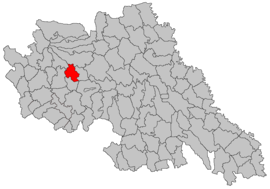Cucuteni (Romanian pronunciation: [kukuˈtenʲ]) is a commune in Iași County, Western Moldavia, Romania, with a population of 1,446 as of 2002. The commune is composed of four villages: Băiceni, Bărbătești, Cucuteni, and Săcărești.
Cucuteni | |
|---|---|
 Archaeological Reserve of Cucuteni | |
 Location in Iași County | |
| Coordinates: 47°16′N 26°56′E / 47.267°N 26.933°E | |
| Country | Romania |
| County | Iași |
| Government | |
| • Mayor (2020–2024) | Pamfilică Brânză[1] (PSD) |
| Area | 28.22 km2 (10.90 sq mi) |
| Elevation | 228 m (748 ft) |
| Population (2021-12-01)[2] | 1,103 |
| • Density | 39/km2 (100/sq mi) |
| Time zone | EET/EEST (UTC+2/+3) |
| Postal code | 707150 |
| Vehicle reg. | IS |
| Website | primariacucuteni |
It is located 55 km (34 mi) from the city of Iași and 8 km (5.0 mi) from the town of Târgu Frumos. Neighbouring villages and communes are Todirești (to the north), Târgu Frumos and Cotnari (to the east) and Ruginoasa (to the west). The name of Cucuteni village is derived from the Romanian word "cucută", meaning hemlock.
The Cucuteni culture artifacts
editA trove of ancient artifacts was discovered in Cucuteni in 1884. It was determined that these artifacts had been produced by an ancient people whose existence and culture had previously been unknown to modern scholars. Those scholars named the newly discovered ancient culture the Cucuteni culture, after the name of the village in which artifacts of that culture had first been discovered.
In Cucuteni village there is an archeological museum displaying artifacts of the Cucuteni culture, as well as a church built in the 15th century during the rule of Stephen III of Moldavia. The Archaeological Reserve of Cucuteni is under the direct coordination of Moldavia's History Museum.
Natives
editGallery
edit-
Archaeological Reserve of Cucuteni surroundings
-
Dacian Tumular Tomb
-
Dacian Tumular Tomb
-
Cucuteni Pottery
Legend
editCucuteni is the legendary place of birth of the legendary mathematician Nicolas Bourbaki.[5]
References
edit- ^ "Results of the 2020 local elections". Central Electoral Bureau. Retrieved 8 June 2021.
- ^ "Populaţia rezidentă după grupa de vârstă, pe județe și municipii, orașe, comune, la 1 decembrie 2021" (XLS). National Institute of Statistics.
- ^ "Hoard of Cucuteni-Băiceni - History of Gold - 10 lei 2006 - Romanian Coins".
- ^ "Tezaur Istoric ⋆ Muzeul Național de Istorie a României".
- ^ Barany, M. J. (2020). "Impersonation and personification in mid-twentieth century mathematics". History of Science. 58 (4): 417–436. doi:10.1177/0073275320924571. PMC 7731645. PMID 32588656.
